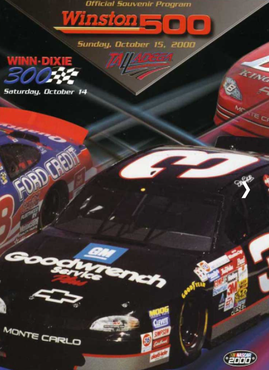Top Qs
Timeline
Chat
Perspective
2000 Winston 500
30th race of the 2000 NASCAR Winston Cup Series From Wikipedia, the free encyclopedia
Remove ads
The 2000 Winston 500 Presented By UPS was the 30th stock car race of the 2000 NASCAR Winston Cup Series, the last of five No Bull 5 events in that year's season, and the 32nd iteration of the event. The race was held on Sunday, October 15, 2000, before an audience of 140,000 in Lincoln, Alabama at Talladega Superspeedway, a 2.66 miles (4.28 km) permanent triangle-shaped superspeedway. The race took the scheduled 188 laps to complete.
In what is considered by NASCAR as one of the most memorable finishes in NASCAR Winston Cup Series history, Richard Childress Racing's Dale Earnhardt managed to come back from the 18th position with five laps left in the race, making a late-race charge to gain the lead by the start of the final lap. Defending against Andy Petree Racing's Kenny Wallace, Earnhardt was able to defend the field to take his 76th and final career NASCAR Winston Cup Series victory, his second and final victory of the season, and a No Bull 5 victory, netting him a bonus of $1,000,000.[1][2] To fill out the top three, the aforementioned Kenny Wallace and his teammate, Joe Nemechek finished second and third, respectively.
Remove ads
Background
Summarize
Perspective

Talladega Superspeedway, originally known as Alabama International Motor Superspeedway (AIMS), is a motorsports complex located north of Talladega, Alabama. It is located on the former Anniston Air Force Base in the small city of Lincoln. The track is a tri-oval and was constructed in the 1960s by the International Speedway Corporation, a business controlled by the France family. Talladega is most known for its steep banking and the unique location of the start/finish line that's located just past the exit to pit road. The track currently hosts the NASCAR series such as the NASCAR Cup Series, Xfinity Series and the Camping World Truck Series. Talladega is the longest NASCAR oval, a 2.66-mile-long (4.28 km) tri-oval like the Daytona International Speedway, which also is a 2.5-mile-long (4.0 km) tri-oval.
Entry list
- (R) denotes rookie driver.
- (N) denotes driver eligible for the No Bull 5.
Remove ads
Practice
Summarize
Perspective
First practice
The first practice session was held on Friday, October 13, at 12:00 PM EST. The session lasted for two hours. Dale Earnhardt, Inc.'s Steve Park set the fastest time in the session, with a lap of 50.105 and an average speed of 191.119 mph (307.576 km/h).[3]
Second practice
The second practice session was held on Saturday, October 14, at 9:15 AM EST. The session lasted for one hour and 15 minutes. Joe Gibbs Racing's Bobby Labonte set the fastest time in the session, with a lap of 48.248 and an average speed of 198.475 mph (319.415 km/h).[3]
Third practice
The final practice session, sometimes referred to as Happy Hour, was held on Saturday, October 14, at 12:45 PM EST. The session lasted for one hour. Penske-Kranefuss Racing's Rusty Wallace set the fastest time in the session, with a lap of 49.693 and an average speed of 192.703 mph (310.125 km/h).[3]
Remove ads
Qualifying
Summarize
Perspective
Qualifying was split into two rounds. The first round was held on Friday, October 13, at 4:00 PM EST. Each driver had two laps to set a fastest time; the fastest of the two counted as their official qualifying lap. During the first round, the top 25 drivers in the round was guaranteed a starting spot in the race. If a driver was not able to guarantee a spot in the first round, they had the option to scrub their time from the first round and try and run a faster lap time in a second round qualifying run, held on Saturday, October 14, at 11:45 AM EST. As with the first round, each driver had two laps to set a fastest time; the fastest of the two would count as their official qualifying lap.[3] Positions 26–36 were decided on time, while positions 37–43 were based on provisionals. Six spots were awarded by the use of provisionals based on owner's points. The seventh was awarded to a past champion who has not otherwise qualified for the race. If no past champion needs the provisional, the next team in the owner points was awarded a provisional.[4]
Joe Nemechek, driving for Andy Petree Racing, managed to win the pole, setting a time of 50.326 and an average speed of 190.279 miles per hour (306.224 km/h) in the first round.[5]
Three drivers failed to qualify: Wally Dallenbach Jr., Blaise Alexander, & Hut Stricklin.
Full qualifying results
Remove ads
Race results
Remove ads
Media
Television
The race was aired live on ESPN. Jerry Punch, 1973 Cup Series champion Benny Parsons and two-time NASCAR Cup Series champion Ned Jarrett called the race from the broadcast booth. Punch filled in for regular commentator Bob Jenkins, who was covering ABC's coverage of the Excite 500 IndyCar Series race at Texas Motor Speedway. Bill Weber, John Kernan and Ray Dunlap handled pit road for the television side.
Remove ads
Standings after the race
Remove ads
References
Wikiwand - on
Seamless Wikipedia browsing. On steroids.
Remove ads

